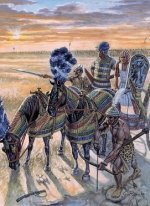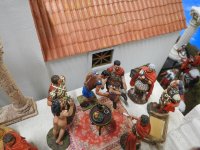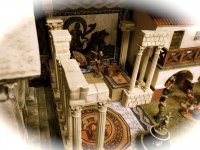Gunn Miniatures
Command Sergeant Major
- Joined
- Jun 18, 2009
- Messages
- 2,729
Dear all, our samples for our May/June release left China on Friday and should be here this Friday, photos of these goodies should appear the following week. Moving on with this weeks news we have some interesting facts about Ancient Egypt for your perusal.
1. Perhaps no figure is more famously associated with ancient Egypt than Cleopatra VII. But while she was born in Alexandria, Cleopatra was actually part of a long line of Greek Macedonians originally descended from Ptolemy I, one of Alexander the Great’s most trusted lieutenants. The Ptolemaic Dynasty ruled Egypt from 323 to 30 B.C., and most of its leaders remained largely Greek in their culture and sensibilities. In fact Cleopatra was famous for being one of the first members of the Ptolemaic dynasty to actually speak the Egyptian language.
2. After a long day’s work along the Nile River, Egyptians often relaxed by playing board games. Several different games were played, including “Mehen” and “Dogs and Jackals,” but perhaps the most popular was a game of chance known as “Senet.” This pastime dates back as far as 3500 B.C. and was played on a long board painted with 30 squares. Each player had a set of pieces that were moved along the board according to rolls of dice or the throwing sticks. Historians still debate Senet’s exact rules, but there is little doubt of the game’s popularity. Paintings depict Queen Nefertari playing Senet, and pharaohs like Tutankhamen even had game boards buried with them in their tombs.
3. While they may have been publicly and socially viewed as inferior to men, Egyptian women enjoyed a great deal of legal and financial independence. They could buy and sell property, serve on juries, make wills and even enter into legal contracts. Egyptian women did not typically work outside the home, but those who did usually received equal pay for doing the same jobs as men. Unlike the women of ancient Greece, who were effectively owned by their husbands, Egyptian women also had the right to divorce and remarry. Egyptian couples were even known to negotiate an ancient prenuptial agreement. These contracts listed all the property and wealth the woman had brought into the marriage and guaranteed that she would be compensated for it in the event of a divorce.
4. Surprisingly little is known about the life of the boy pharaoh Tutankhamen, but some historians believe they know how he died. Scans of the young king’s body show that he was embalmed without his heart or his chest wall. This drastic departure from traditional Egyptian burial practice suggests that he may have suffered a horrific injury prior to his death. According to a handful of Egyptologists, one of the most likely causes for this wound would have been a bite from a hippopotamus. Evidence indicates that the Egyptians hunted the beasts for sport, and statues found in the King's tomb even depict him in the act of throwing a harpoon. If the boy pharaoh was indeed fond of stalking dangerous game, then his death might have been caused by a hunt that went horribly wrong.
5. An ancient physician was usually a jack-of-all-trades, but evidence shows that Egyptian doctors sometimes focused on healing only one part of the human body. This early form of medical specialization was first noted in 450 B.C. by the traveler and historian Herodotus. Discussing Egyptian medicine, he wrote, “Each physician is a healer of one disease and no more…some of the eye, some of the teeth, some of what pertains to the belly.” These specialists even had specific names. Dentists were known as “doctors of the tooth,” while the term for proctologists literally translates to “shepherd of the anus.”
Moving on we have factory pictures of our new Egyptian officer who is due to be released shortly, a big thanks to Mike Miller for his help with some of the finer details of this piece. Please note the Leopard will be glued to the base. This figures is designed to be used with our Pharaohs daughters as a sentry, but of course can be used in any Ancient Egyptian setting.
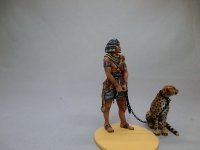
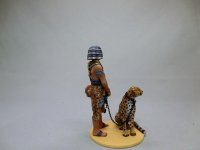
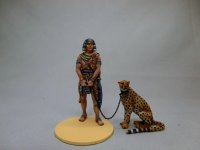
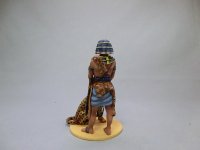
That's all for this week, we hope you enjoyed the news update.
Best wishes The Gunn Team
1. Perhaps no figure is more famously associated with ancient Egypt than Cleopatra VII. But while she was born in Alexandria, Cleopatra was actually part of a long line of Greek Macedonians originally descended from Ptolemy I, one of Alexander the Great’s most trusted lieutenants. The Ptolemaic Dynasty ruled Egypt from 323 to 30 B.C., and most of its leaders remained largely Greek in their culture and sensibilities. In fact Cleopatra was famous for being one of the first members of the Ptolemaic dynasty to actually speak the Egyptian language.
2. After a long day’s work along the Nile River, Egyptians often relaxed by playing board games. Several different games were played, including “Mehen” and “Dogs and Jackals,” but perhaps the most popular was a game of chance known as “Senet.” This pastime dates back as far as 3500 B.C. and was played on a long board painted with 30 squares. Each player had a set of pieces that were moved along the board according to rolls of dice or the throwing sticks. Historians still debate Senet’s exact rules, but there is little doubt of the game’s popularity. Paintings depict Queen Nefertari playing Senet, and pharaohs like Tutankhamen even had game boards buried with them in their tombs.
3. While they may have been publicly and socially viewed as inferior to men, Egyptian women enjoyed a great deal of legal and financial independence. They could buy and sell property, serve on juries, make wills and even enter into legal contracts. Egyptian women did not typically work outside the home, but those who did usually received equal pay for doing the same jobs as men. Unlike the women of ancient Greece, who were effectively owned by their husbands, Egyptian women also had the right to divorce and remarry. Egyptian couples were even known to negotiate an ancient prenuptial agreement. These contracts listed all the property and wealth the woman had brought into the marriage and guaranteed that she would be compensated for it in the event of a divorce.
4. Surprisingly little is known about the life of the boy pharaoh Tutankhamen, but some historians believe they know how he died. Scans of the young king’s body show that he was embalmed without his heart or his chest wall. This drastic departure from traditional Egyptian burial practice suggests that he may have suffered a horrific injury prior to his death. According to a handful of Egyptologists, one of the most likely causes for this wound would have been a bite from a hippopotamus. Evidence indicates that the Egyptians hunted the beasts for sport, and statues found in the King's tomb even depict him in the act of throwing a harpoon. If the boy pharaoh was indeed fond of stalking dangerous game, then his death might have been caused by a hunt that went horribly wrong.
5. An ancient physician was usually a jack-of-all-trades, but evidence shows that Egyptian doctors sometimes focused on healing only one part of the human body. This early form of medical specialization was first noted in 450 B.C. by the traveler and historian Herodotus. Discussing Egyptian medicine, he wrote, “Each physician is a healer of one disease and no more…some of the eye, some of the teeth, some of what pertains to the belly.” These specialists even had specific names. Dentists were known as “doctors of the tooth,” while the term for proctologists literally translates to “shepherd of the anus.”
Moving on we have factory pictures of our new Egyptian officer who is due to be released shortly, a big thanks to Mike Miller for his help with some of the finer details of this piece. Please note the Leopard will be glued to the base. This figures is designed to be used with our Pharaohs daughters as a sentry, but of course can be used in any Ancient Egyptian setting.




That's all for this week, we hope you enjoyed the news update.
Best wishes The Gunn Team



